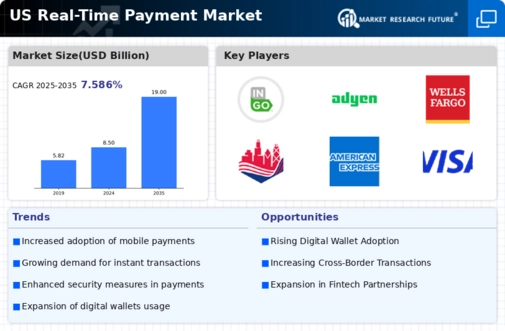The real time-payment market is characterized by a rapidly evolving competitive landscape, driven by technological advancements and changing consumer preferences. Major players such as Visa (US), Mastercard (US), and PayPal (US) are at the forefront, each adopting distinct strategies to enhance their market positioning. Visa (US) focuses on innovation through its extensive network, emphasizing partnerships with fintech companies to expand its service offerings. Mastercard (US) is similarly engaged in digital transformation, leveraging its data analytics capabilities to provide tailored solutions for businesses. PayPal (US), on the other hand, is enhancing its user experience by integrating various payment options, thereby fostering customer loyalty and engagement. Collectively, these strategies contribute to a dynamic competitive environment, where agility and adaptability are paramount.
In terms of business tactics, companies are increasingly localizing their operations to better serve regional markets, optimizing their supply chains to enhance efficiency. The market structure appears moderately fragmented, with a mix of established players and emerging fintech startups. This fragmentation allows for diverse offerings, yet the collective influence of key players like Visa (US) and Mastercard (US) remains substantial, as they continue to set industry standards and drive innovation.
In October 2025, Visa (US) announced a strategic partnership with a leading blockchain technology firm to enhance its real time-payment capabilities. This move is significant as it positions Visa (US) to leverage blockchain's transparency and security features, potentially attracting a broader customer base seeking reliable payment solutions. The integration of blockchain technology may also streamline transaction processes, reducing costs and improving efficiency.
In September 2025, Mastercard (US) launched a new initiative aimed at integrating artificial intelligence (AI) into its payment processing systems. This initiative is crucial as it enables Mastercard (US) to enhance fraud detection and improve customer service through predictive analytics. By harnessing AI, Mastercard (US) is likely to gain a competitive edge, offering faster and more secure transactions that meet the evolving demands of consumers.
In August 2025, PayPal (US) expanded its services to include cryptocurrency transactions, allowing users to buy, sell, and hold digital currencies directly within their accounts. This strategic expansion reflects PayPal's commitment to innovation and its recognition of the growing importance of cryptocurrencies in the payment landscape. By embracing this trend, PayPal (US) positions itself as a forward-thinking player, appealing to a tech-savvy demographic that values flexibility in payment options.
As of November 2025, current trends in the real time-payment market indicate a strong emphasis on digitalization, sustainability, and AI integration. Strategic alliances among key players are shaping the competitive landscape, fostering collaboration that enhances service offerings and operational efficiencies. Looking ahead, competitive differentiation is likely to evolve, with a shift from price-based competition to a focus on innovation, technology, and supply chain reliability. Companies that prioritize these elements may find themselves better positioned to navigate the complexities of the market and meet the demands of an increasingly discerning consumer base.

























Leave a Comment